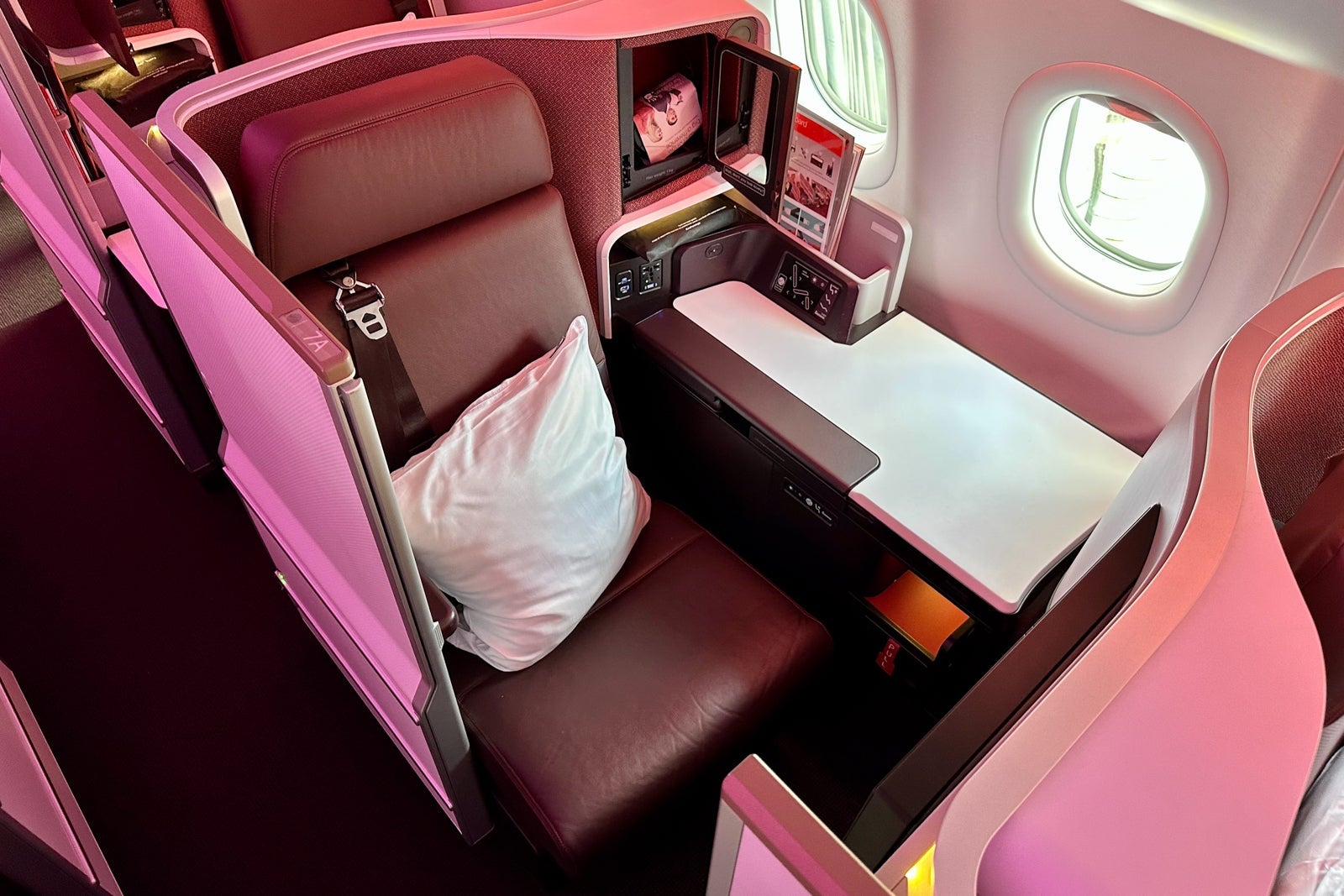The American Express Platinum Card® is one of our favorite cards for booking flights and a beast at earning in this category.
Beyond that, the Platinum Card is an excellent premium travel rewards card, especially for frequent Delta flyers. It offers many statement credits and perks that elevate the travel experience.
Delta and Amex have a close partnership, so frequent flyers have some compelling reasons to consider adding this card to their wallets. Here’s what you should know as a Delta flyer when considering applying for the Platinum Card.
Maximize your airfare purchases
The Platinum Card is at the top of the mountain when it comes to earning rewards when booking flights, with only a few other cards offering comparable earning rates.

It earns 5 points per dollar spent on airfare purchases made directly with the airline or through American Express Travel® on up to $500,000 spent on these purchases per calendar year (then 1 point per dollar thereafter). Based on TPG’s October 2025 valuations, American Express Membership Rewards are worth 2 cents apiece, making this a 10% return.
Delta SkyMiles is a 1:1 transfer partner of Amex. So, if you transfer your points to Delta, earning 5 Membership Rewards points per dollar spent is effectively like earning 5 SkyMiles per dollar spent on airfare.
This is better than what you can earn on Delta flight purchases with a cobranded Delta credit card, as the maximum you can earn is just 3 miles per dollar spent.
Earn valuable points
The Platinum Card earns Membership Rewards points that can be transferred to a wide range of airline and hotel loyalty programs, including Delta.
The Platinum Card shines by offering travelers flexibility. You don’t have to focus exclusively on the Delta SkyMiles program like you would if you were only earning SkyMiles with one of the airline’s cobranded credit cards.
The Platinum Card offers the best of both worlds as you can still use your Amex points for Delta flights, but you have many other options to choose from.

Delta may be your preferred airline, but having a stash of transferable points is beneficial for the following reasons:
- It gives you more options to book airlines and hotels that you normally might not consider
- You can sometimes book tickets on your preferred airline through a partner at a lower rate than booking directly with that airline. Additionally, partners sometimes offer transfer bonuses, which can make these award tickets even cheaper.
- Flexible points protect you from loyalty program devaluations, which Delta tends to do frequently.
- It minimizes the risk of airline bankruptcies and program suspensions.
Transferable points, such as Membership Rewards points, can even serve as a financial safety net for unplanned expenses and emergencies, as you could redeem your points for cash back, although at a poor redemption rate.
As long as you have Membership Rewards points, you have SkyMiles whenever you need them. But if a different opportunity arises, you’re ready for that, too.
Related: How to redeem your Delta SkyMiles for maximum value
Transfer to Delta (and its partners)
As mentioned above, you can instantly transfer the Amex Membership Rewards points you earn with the Platinum Card (and other eligible cards) to Delta at a 1:1 ratio. This is a great way to top off your Delta SkyMiles balance if you need extra miles for a particular redemption.
American Express is also Delta’s exclusive partner for its lineup of cobranded credit cards, so you’ll likely enjoy this benefit for years to come.

However, one of the main reasons to accumulate points with Amex rather than miles exclusively with Delta is that you can leverage the power of airline partnerships beyond Delta’s SkyMiles program.
With the Platinum Card, you can transfer your points to 16 other airline partners. However, with a Delta cobranded card, you’d be limited to redeeming miles for flights operated only by Delta and its partners.
As an example, you can transfer Membership Rewards points to Virgin Atlantic Flying Club. This is especially useful because you can often book Delta One business-class seats through Virgin Atlantic for far fewer points than Delta charges.
As with any transferable currency, you should only transfer when you’re confident that there’s available award inventory and you are ready to book your ticket. Transfers only go one way: Once you transfer Amex points out, you can’t convert them back into Membership Rewards points.
Related: How (and why) you should earn transferable credit card points
Airport benefits
Aside from the excellent earning rates on flights, the Platinum Card has several day-of-travel perks that can save you time and money and elevate your travel experience.
Many Delta loyalists will opt for the airline’s top-tier personal card, the Delta SkyMiles® Reserve American Express Card, to access Sky Clubs when flying Delta. Cardmembers are limited to 15 visits per year, unless you spend $75,000 on your card in a calendar year.
By contrast, with the Platinum Card, eligible cardmembers get 10 visits per year (five fewer), unless you spend $75,000 on your card in a calendar year to unlock unlimited access.

With both cards, eligible cardmembers can also access Centurion Lounges. The key difference is that you can only access them with the Delta Reserve card if you’re flying on Delta and purchased your ticket with a U.S. Amex-issued card. Meanwhile, with the Platinum Card, you can enter the Centurion Lounge regardless of which airline you’re flying with.
Additionally, the Platinum Card offers an up to $200 airline fee statement credit per calendar year, which can cover checked bag fees or seat selection on the airline you select each calendar year. (Enrollment required)
If you’re flying Delta (or another U.S.-based airline) and don’t want to get one of the airline’s cobranded cards with a free checked bag, you can offset the cost through your Platinum card.
Lastly, the Platinum offers an up to $209 Clear Plus statement credit each calendar year (subject to auto-renewal; enrollment required). Clear Plus is an expedited biometric security program that lets you skip to the front of the TSA line.
When paired with the $120 statement credit for Global Entry every four years or an up to $85 fee credit for TSA PreCheck every 4½ years that the Platinum card offers, you’ll breeze through security in no time.
Related: Best credit cards for airport lounge access
A reason to still consider Delta cobranded cards
While the Platinum Card is a solid all-around choice for Delta flyers, select Delta cobranded cards have a distinct edge.
If you want to earn Delta Medallion elite status, holding a Delta cobranded credit card can get you there faster. You can earn Medallion Qualification Dollars by spending on one of the following cards:
- Delta SkyMiles® Platinum American Express Card and Delta SkyMiles® Platinum Business American Express Card: Earn 1 MQD per $20 spent in a calendar year.
- Delta SkyMiles Reserve American Express Card and Delta SkyMiles® Reserve Business American Express Card: Earn 1 MQD per $10 spent in a calendar year.
You’ll also receive an annual MQD Headstart that automatically deposits 2,500 MQDs on all these cards each year. If you spend enough annually on a cobranded card, you could earn status without even stepping on a Delta jet. Additionally, if you hold a combination of any two of the cards above, you’ll receive 5,000 MQDs, which will automatically grant you Silver Medallion status.
The Platinum Card can’t help you earn elite status without flying, so if status is a top priority, you’ll be better suited with a Delta cobranded option.
Bottom line
The Platinum Card has a steep $895 annual fee (see rates and fees), but the cost can be easily justified if you take advantage of even just half of the perks available.
The Platinum Card earns our top spot as the best premium card for Delta flyers, thanks to benefits including Sky Club access when flying Delta, earning flexible points that can be transferred to Delta and a useful up to $200 per calendar year airline fee incidental statement credit.
However, if you specifically want to earn MQDs toward elite status through spending and a welcome offer, you’ll still want to consider one of Delta’s cobranded cards.
To learn more, check out our full review of the Amex Platinum.
Apply here: American Express Platinum Card
For rates and fees of the Amex Platinum, click here.
Editorial disclaimer: Opinions expressed here are the author’s alone, not those of any bank, credit card issuer, airline or hotel chain, and have not been reviewed, approved or otherwise endorsed by any of these entities.




